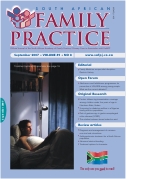Role Of Gastroscopy In Gastro-Oesophageal Reflux Disease (GORD)
Keywords:
Gastro-oesophageal reflux disease, gastroscopy, complications, empirically, alarming symptoms
Abstract
Background This two-year study is a retrospective analysis of records of patients diagnosed with gastro-oesophageal reflux disease (GORD) at a private medical aid society for the period January 2002 to December 2003. In this study of GORD and its complications, the use of gastroscopy as a staging criteria and the cost of treatment were evaluated. Patients with alarming symptoms (chronic gastrointestinal bleeding, progressive unintentional weight loss, progressive difficulty in swallowing, persistent vomiting, iron deficiency anaemia, epigastric mass or suspicious barium meal), those with complications of GORD (erosive oesophagitis, ulcerative oesophagitis, oesophageal strictures, Barrett’s oesophagus and oesophageal adenocarcinoma), and patients in whom symptoms have not resolved need to have a gastroscopy performed. If left untreated, some of these symptoms could lead to more severe and serious complications. Accurate recognition of these symptoms will help to identify, evaluate and treat patients timeously. The use of the gastroscopy allows for the detection of complications of GORD, which helps to identify patients with complications timeously and avoids, delays or stops the progression of the complications of GORD. However, the unnecessary use of gastroscopy in patients without complications results in unnecessary costs. Patients without alarming symptoms or complications should be treated empirically with proton pump inhibitors (PPIs) to resolve the symptoms of GORD. Methods One thousand seven hundred and fifty-three patients with GORD were identified from computer records at a private medical aid society for the period January 2002 to December 2003. These patient records were retrospectively analysed using the computer database. All newly diagnosed GORD patients (n = 586) who were on drug therapy were included in the study. These patients were divided into two subsets: those without gastroscopy (n = 211) and those with gastroscopy (n = 375). The latter group was further identified as those that had undergone one (n = 232) or more than one gastroscopy (n = 143). Patients were further subdivided into those with and without complications. The choice of the study population was not based on the complication or the severity of the symptoms, but on whether or not the attending doctor chose to have a gastroscopy done. Results The number of complications detected in patients with more than one gastroscopy was the highest (34%; n = 48) in comparison to patients with one gastroscopy (21%; n = 49) or without gastroscopy (7%; n = 15) (p < 0.001). The odds or chances of having complications were significantly greater in patients with one gastroscopy compared to those without gastroscopy (OR 3.5; 95% CI: 1.8-6.9). Having an additional gastroscopy increased the odds of complications significantly compared to patients with just one gastroscopy (OR 1.9; 95% CI: 1.1-3.1). Barrett’s oesophagus occurred in 1.9% (n = 4) of patients without gastroscopy and in 15.7% (n = 59) of patients with gastroscopy (p < 0.001). Discussion Patients without gastroscopy presented with the lowest number of complications. The performance of gastroscopy in patients with alarming symptoms or complications may have resulted in more complications being detected. In subjects without gastroscopy, the prevalence of Barrett’s oesophagus was low. The proportion of subjects with complications is strongly associated with the number of gastroscopies they had undergone. Multiple gastroscopies increased the likelihood of detecting complications. Thus, a gastroscopy should only be performed if the symptoms of GORD do not resolve or if the patient has alarming symptoms or complications after empirical therapy. Conclusion The performance of gastroscopy in patients who had not undergone a gastroscopy before may have resulted in more complications being detected. Having more than one gastroscopy significantly increased the odds of detecting complications compared to patients with who had only undergone one gastroscopy. Patients without alarming symptoms should be treated empirically for one to two months, and a gastroscopy should only be performed if the symptoms do not resolve or if the patients experience complications or alarming symptoms.1 This study was confined to a single medical aid society. For comparison, other medical aids should be included.
Published
2007-09-04
Section
Original Research
By submitting manuscripts to SAFP, authors of original articles are assigning copyright to the South African Academy of Family Physicians. Copyright of review articles are assigned to the Publisher, Medpharm Publications (Pty) Ltd, unless otherwise specified. Authors may use their own work after publication without written permission, provided they acknowledge the original source. Individuals and academic institutions may freely copy and distribute articles published in SAFP for educational and research purposes without obtaining permission.

